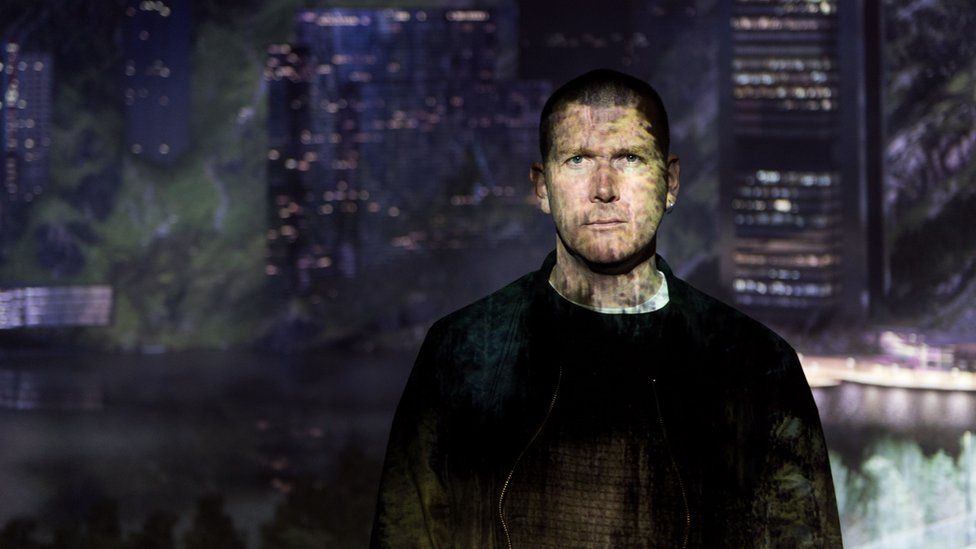Artes Mundi: Artists inspired by migration and future cities
- Published

Work from six contemporary artists from around the world is being showcased at the seventh Artes Mundi exhibition, which opens in Cardiff on Friday.
Themes of migration and global politics are tackled on the shortlist for the biennial £40,000 prize.
Welsh artist Bedwyr Williams imagines a futuristic city built on the slopes of Cadair Idris.
Curator Karen MacKinnon said: "These artists question what it means to be human in our world and in our time."
With the final touches still being carried out to some exhibits at National Museum Wales, she added that the artists brought "humour, surrealism and provocation".
"What connects this diverse exhibition is relevance and urgency, as they comment on and question the spirit of our age."
Two of the shortlisted artists have work at Chapter Arts Centre.
They have been selected from more than 700 nominations submitted from 90 countries.
SHORTLISTED ARTISTS
John Akomfrah (UK)
Ghanaian-born filmmaker and founder of the Black Audio Film Collective. Akomfrah's video installation over two screens looks at five centuries of migration and religious persecution.
It was inspired while he was teaching in Barbados in 2009 and he saw a cemetery containing 17th Century graves of Sephardic Jewish refugees who had fled Brazil: "I was asking 'how did they get here?'"
Neil Beloufa (France/Algeria)
His video installation World Domination, projected onto a relief of a dinosaur, uses ordinary people from different continents "play acting" as presidents, discussing different issues but instructed to declare war.
Ms MacKinnon called it "dark but very funny," while Beloufa talks of "how easy they get crazy and escalate it".
Amy Franceschini/FutureFarmers (USA/Belgium)
Those at the preview were given the "social media" of seeds of grain to take away with them.
This is only the start of the voyage for this artwork in what is being called "an act of reverse migration."
Seeds taken from museums, farms and found on historic sites have been brought to Cardiff on board a 19th Century Norwegian rescue vessel cum laboratory.
They will embark on a journey to London and onto the Middle East, meeting more farmers and artisan bread-makers and exchanging seeds.
Lamia Joreige (Lebanon, work both at National Museum Wales and Chapter)
The starting point for Mathaf (Arabic for museum) from this visual artist is the collection of the destroyed National Museum of Beirut, in particular a fragment of Roman mosaic, damaged by a hole from a sniper's bullet.
A concrete cast of the bullet hole, pictograms shot by a pinhole camera and an inventory of objects saved in the museum's archive.
A separate video installation of a river brings social history and the gentrification of a neighbourhood.
Nastio Mosquito (Angola, at Chapter)
Poet, musician, video and digital artist Nastio is premiering The Transitory Suppository, depicting the fictional depot A L Moore of a country called Botrovia.
Bedwyr Williams (UK/Wales)
A 20-minute video on a wall, slowly computer-animated, Tyrrau Mawr shows an imaginary city which has sprung up on the slopes of Cadair Idris near Dolgellau, one of Wales' most recognisable peaks.
His narration, laced with dark humour, tells snippets of stories of the inhabitants, as the cityscape slowly turns from night to day.
"I wondered about this business of rapidly building huge cities in completely undeveloped places like in the oil rich countries in the Middle East or in China," Gwynedd-based Williams says of the work.
"I've also been playing this game Clash of Clans with my son on my iPhone and I've becoming a little hooked on building imaginary fortresses."
It is the first time since Cardiff-based painter Sue Williams in 2006 that a Welsh artist has made the shortlist.
Analysis by Huw Thomas, BBC Wales arts and media correspondent
Imposing video installations by Bedwyr Williams and John Akomfrah dominate the Artes Mundi exhibition, while the conscientious work of the FutureFarmers exemplify the prize's theme of the human condition.
The challenge for the organisers is to make an impression on an audience that has become a little weary of contemporary art prizes.
Beyond the exhibition spaces at National Museum Wales and Chapter, Artes Mundi's work in communities will add value to an event which would otherwise risk entombing a bold contemporary art prize within the walls of traditional artistic institutions.
The home crowd will be pleased to see Williams on the shortlist, only the third time in the prize's 12-year history that a Welsh artist has been selected.
But he faces considerable competition for the £40,000 prize when the jury considers its artistic verdict in the new year.
The exhibition runs from 21 October until 26 February 2017, with the prize announced on 25 January.
The last winner, Theaster Gates in 2015, chose to split the prize fund equally between the whole shortlist.
- Published17 September 2015
- Published23 January 2015
- Published1 June 2013
- Published19 April 2011